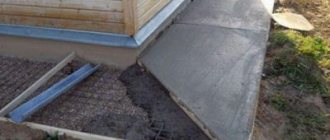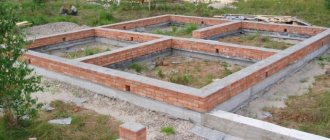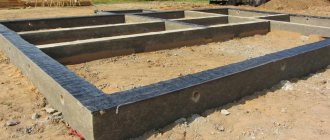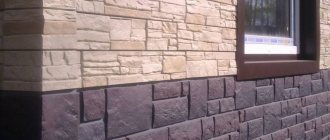The distance between the base and the soil, specially arranged to improve the performance characteristics of the building’s base and ease of movement, is called the blind area.
Structures can be hard (concrete, asphalt), semi-rigid (paving slabs) and soft (crushed stone).
Made in full accordance with the technologies established by GOST 7473-94 (9128-97), the blind areas are durable and protect the foundation well.
If the technology is violated or its service life expires, defects arise, the timely elimination of which helps restore the functions and purpose of the structure. How to consistently repair the blind area around the house with your own hands and what is needed for this, read in detail in the article below.
Repair features
There are several types of blind area:
- cobblestone;
- concrete;
- asphalt;
- tiled.
Its restoration depends on the materials used in its manufacture.
Repairing a cobblestone line involves replacing damaged areas. To do this you will need a chisel and a hammer. Using these tools, deformed cobblestones are removed from the structure. It is necessary to pour a mixture of sand and gravel or crushed crushed stone onto the empty space to level the layer, then compact everything well, fill it with cement mortar and insert a cobblestone of a suitable size. If there are small cracks, it will be enough to seal them with concrete.
Concrete protective strips are most often used due to their affordability and positive performance qualities.
Repair of a concrete blind area is divided into two types:
- Covering up small isolated tears.
- Replacement of large destroyed areas when the house subsides.
To prevent further deformation of the coating and the entry of water into the foundation of the house, repairs must be carried out immediately immediately after defects are discovered.
To eliminate damage, you can use mixtures of concrete and construction adhesive, special polymer materials, and moisture-resistant polyurethane foam . Penetrating into the cracks formed, such mixtures quickly harden. It is necessary to pay attention to the fact that cement is not suitable for these purposes, because it does not cover the entire depth of the crack, but only its upper part.
In case of severe deformation and deep subsidence of the blind area, the destroyed areas are completely replaced.
When restoring an asphalt strip, all areas to be repaired must be dismantled to its entire depth. The resulting pit is cleaned, and its bottom and edges are treated with liquid resin. After this, a new layer of asphalt is covered and compacted with a roller, and the new layer should be higher than the old one.
Rolling out the new coating must be done from the edges towards the center. The result will be a stronger grip.
Restoring a tile blind area involves replacing its defective part. Before replacing a new one, crushed stone or sand is added to the recess, after which a new tile is laid.
If there is a need to replace a large part of the tape, you can use a mixture of sand and cement in dry form using gunite (the solution is applied with a cement gun under compressed air pressure). After shotcreting, the surface must be moistened for 14 days.
Elimination of defects without dismantling
If it is planned to carry out work without dismantling the old blind area, then the technology and sequence of work changes somewhat:
- Only the most falling off parts of the base are removed, easily swept away with a hard broom. Narrower cracks are slightly widened with a spatula.
- Apply a good, thick coat of primer with a thick brush to strengthen the cracked coating.
- The leveling screed is made with a repair mixture or plastic construction mortar to which PVA is added.
- Apply waterproofing made of roofing felt or polyethylene film, with an overlap of up to 8 cm on the base.
- The reinforced wire mesh is laid on top and the concrete solution is poured, maintaining a slope of up to 3 cm and a layer of up to 8 cm. When dry, the solution is strengthened with iron (dry or wet), using cement and levelers.
- The filling should be done so that transverse seams are formed at the base. But some masters believe that this is not necessary. Seams are needed where there is a tendency to shrinkage deformations of the building and unstable atmospheric temperature. The seam is made of rigid foam, which is then removed after the solution has set.
To ensure that the edges of the blind area are smooth, formwork is installed. After the area to be restored has hardened, the board is removed and soil is added. Some owners sprinkle gravel of any color and different fractions for decorative purposes, which gives the structure a complete and interesting look.
If a thin layer of concrete is required (up to 5 cm), a small thickening should be made closer to the edge, 2 times larger than the pouring area (tooth). Then a curb is placed near the edge (a brick can be used). No formwork is needed here.

To carry out repairs, you need tools such as:
- bucket,
- shovel,
- building level,
- consumables (sand, cement, polymers, crushed stone, water),
- mounting hammer,
- fittings,
- construction plastering tools (trowel, trowel, thread, brushes, etc.).
Small cracks are filled with a small amount of cement mortar or building polymer. If the masonry is damaged, re-lay the section of tiles (paving stones), tapping it well.
Typical mistakes when constructing blind areas
The desire to reduce costs when choosing a design, building materials and technology leads to the fact that soon after the construction of a protective tape it has to be repaired. And upcoming repairs will require large financial expenses.
Let's look at the most common mistakes made when making strips:
- The absence of a leveling layer will lead to rapid settlement of the protection. To prevent this from happening, it is necessary to make a good connection of the tape to the foundation.
- A thin leveling layer and poor compaction lead to subsidence and the formation of cracks.
- The absence of longitudinal and transverse expansion (temperature) joints between the strip and the foundation - with temperature changes and soil movements, the structure will not be able to shrink and expand. As a result, restoration may be required after the first winter. The expander can be roofing material folded in two layers, located between the foundation and concrete.
- Lack of sand and gravel layer - when laying concrete directly on the ground, the heaving of the soil will lead to deformation of the protective strip.
- As the thickness of the tape decreases towards the edge, it is destroyed under the influence of streams of water flowing from the roof of the building.
- Lack of gutters - the surface of the blind area crumbles from the flowing water.
- Not reinforcing the concrete strip - in this case, the service life of the structure is reduced.
- Using a mixture of sand and clay when laying the blind area - under the influence of frozen clay, parts of the concrete may peel off.
- Pouring concrete without dividing it into segments will lead to rapid destruction of the entire tape.
How to fill the seam when the blind area moves away from the building?
According to the technology, the blind area and the base are not rigidly secured to each other. This is caused by the uneven shrinkage of both structures. Therefore, it is imperative to leave a seam around the entire perimeter to compensate. It is covered with special materials, hermetically sealed along the outer surface from atmospheric influences.
Sew up the resulting gap between the base and the blind area with polyurethane sealant or medium-thick polystyrene foam. Foam, tapes or bitumen mastics are often used.
First, a rope of foamed polyethylene is placed into the crack, which creates a specific bottom that holds the polyurethane sealant. It “seizes” at high speed and firmly seals the seam; the entire seam is rubbed over with cement mortar on top.
Advantages of sealing seams with polyethylene tape and polyurethane sealant:

highest thermal insulation;- low thermal conductivity;
- good resistance to moisture penetration;
- elasticity;
- reliability;
- ease of processing;
- long service life;
- compatibility with concrete and stone.
When is a major overhaul needed?
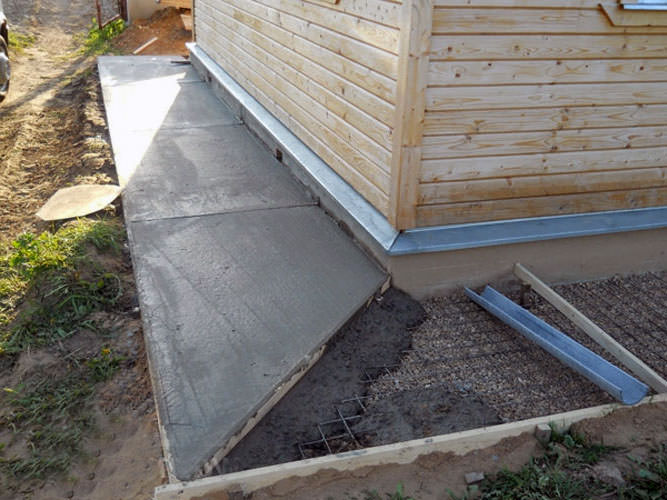
The decision on the need to repair the protective strip is made after a detailed study and establishment of the technical condition of the strip and foundation.
Major restoration is carried out in the event of almost complete destruction of the blind area.
This type of restoration includes:
- slab renewal;
- replacement or restoration of the drainage system;
- repair of the reinforcing frame;
- waterproofing renewal;
- cleaning from moss and lichen;
- dismantling the old tape or replacing its new parts.
Small cracks existing in one area are combined into one zone, expanded, and then crushed stone is poured into the resulting depression and filled with polymer concrete.
During major repairs, a layer of concrete is poured above the level of the previous protective strip - this ensures better adhesion of the new one to the old one.
Often the costs of carrying out this work are very high, so it is advisable to completely replace the blind area.
Necessary materials
To repair the blind area, you need to use high-quality materials and strictly follow construction technology.
Let's consider the list and quantity of materials required to perform work to eliminate defects in the protective strip.
To repair a concrete blind area (width 1 meter, thickness 10 centimeters) you will need:
To prepare concrete (1 m2):
- cement M 500 – 32 kg;
- screenings or crushed stone (5-10 mm) – 0.08 m3;
- sand – 0.05 m3;
For the pillow:
- geotextiles, PVC film – 1m2;
- sand – 0.05-0.1 m3;
- screenings or crushed stone (3-10 mm) - 0.1 m3;
Reinforcement:
- reinforcement, diameter 6 mm – 12 m.p.;
- reinforcing mesh 50x50, diameter 3 mm – 1m2;
- reinforcement mesh 150x150, diameter 3 mm – 1m2.
To repair a tiled blind area (1 meter wide), consumption per 1 m2:
Pillow:
- clay – 0.05-0.1 m3;
- geotextiles, PVC film – 1m2;
- sand – 0.15-0.2 m3;
- screenings or crushed stone (3-10 mm) – 0.1 m3;
Finishing layer:
- cement M 500 – 10 kg;
- sifted sand – 2.5-10 kg;
Front layer:
- tiles – 50 pieces;
- border – 2 pcs.
Approximate costs
Calculation of material used for repair-related costs , depending on the material and the problem detected (routine repairs and major repairs), may be as follows:
| Material for 1 m2 | Cost per quantity used (in rubles) |
| Cement (grade M from 200 to 500) | 100 |
| Sand (river) | 140 |
| Gravel (up to 20 mm) | 340 |
| PVA glue | 30-50 |
| Reinforced mesh | 400-455 |
| Insulation (extruded polystyrene foam), 1 sheet | 180 |
| Foam concrete (cylinder) | 220 |
| Sealant | 100 |
| Complete dismantling | 700-1000 (for all materials) |
| Geotextiles | 50 |
| Primer | 280 |
The approximate cost includes all components that are involved in repairing the problem area . Many substances remain (glue, primer, foam concrete, sealant), so they can be used for other purposes.
The price also depends on the region of purchase. The most expensive purchase of materials will be in the Moscow and Novosibirsk regions. The cheapest prices are in the Saratov and Bryansk regions.
If there are no construction tools at home, then the cost of consumables is also added to the cost of a spatula, brushes, brushes, trowel, levels, etc.
Minor damage repair technology

The technological process for sealing small cracks and chips consists of the following steps:
- cleaning the surface of the protective line in the area of the depression or chip;
- shallow cracks are treated with two layers of a deeply penetrating primer solution;
- Defects are sealed using cement-sand mortar in a ratio of 1:2. A spatula is used for this work. Half an hour after filling the cracks, the sealing area must be rubbed with a wooden trowel and dry cement;
- defects such as peeling are eliminated by cleaning and filling the areas with bitumen mastic, asbestos and slag. It is recommended to use the composition in the following proportions: 75% - mastic, 15% - asbestos, 10% - crushed slag. After sealing, pour a layer of sand onto the surface.
How to choose quality compounds?
In order to correctly select a mixture for restoring the blind area of a house, the following factors must be taken into account:
- type of destruction;
- size of the detected defect;
- conditions for using the blind area.
To strengthen the concrete surface, deep-penetrating impregnations are mainly used. There are also quick-hardening impregnations that allow you to complete repair work in 6-8 hours.
To work with blind areas, craftsmen prefer to use liquid casting mixtures. They are able to increase the strength of the top layer of the structure, have the least shrinkage and increased adhesion.
DIY blind area repair
It is best to carry out restoration work in early spring or late autumn, then all defects are best revealed, and the concrete is at rest (does not expand under the influence of high temperature and sunlight).
It is necessary to constantly monitor the condition of the protective strip and make timely repairs. This is not particularly difficult and does not require special efforts or qualifications in construction.
Step-by-step instruction
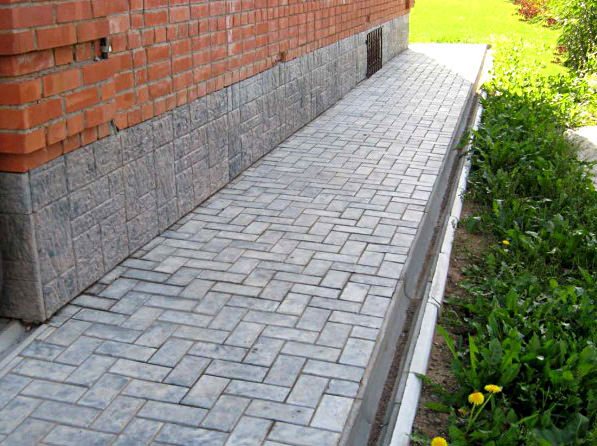
One of the most problematic areas of the blind area is the place where it connects to the base of the house. Approximately half of all problems occur when the blind area separates from the foundation.
If the peeling is small, you can use sealant or waterproofing fillers.
If a large gap forms, it must be eliminated immediately, but this will require much more effort, time and money.
When repairing on your own, professionals advise carrying out the following work:
- Clear the gap of sand, soil and debris.
- Fill the cracks with concrete. For durability, steel reinforcing mesh can be added during concreting.
- A few days after the solution has hardened, the surface must be treated with a primer for external work.
- For prevention purposes, it is recommended to dig a hole of 20-30 centimeters and fill it with solution.
- To eliminate cracks and cracks, it is best to use the material that was used to construct the blind area.
- In the event of complete destruction of the protective tape due to soil subsidence, the destroyed part should be completely dismantled, the soil should be removed, and the lining layer should be restored. Clay is compacted into the recess in a 20-centimeter layer, then sand in a layer of 10-15 centimeters, which can be moistened and compacted again. Cover the sand with crushed stone or broken brick in a layer of 10 centimeters. Then the formwork is constructed and the concrete is poured. For reliability, the repaired area is covered with reinforcing mesh. To achieve a better connection, the old section needs to be increased by 1-2 centimeters.
Rules for working with impregnations
When treating concrete with impregnations, follow the following recommendations:
- The blind area is cleaned of dust and dirt. It is better to repair chips and cracks with cement mortar.
- The concrete sheet is polished using a grinder.
- Apply the solution at temperatures from +5 to +40 C. Rollers and brushes are used.
- The concrete is impregnated several times: the 2nd layer is applied after 1 hour, the 3rd - 3 hours after the second.
While working, wear goggles, a protective mask or respirator, as well as gloves and an apron.

